Alibaba Dropshipping 2025: An Ultimate Guide for Your Store (Plus AliExpress Tips)
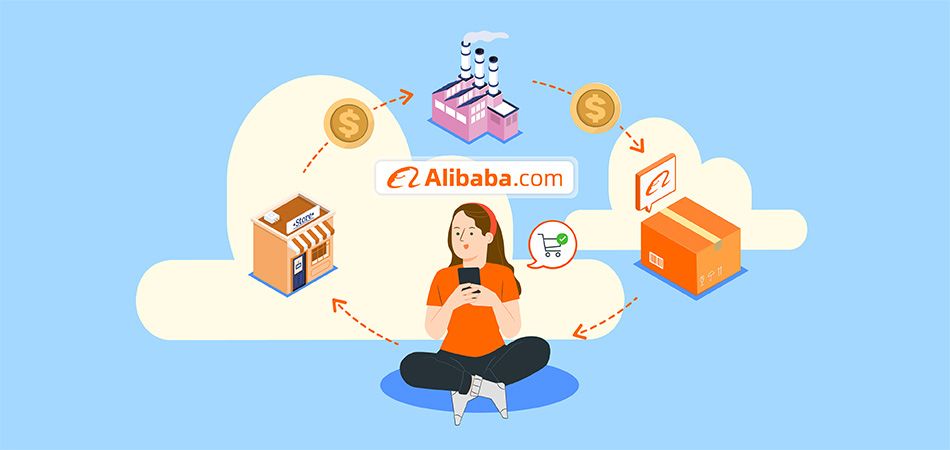
Looking to scale your dropshipping business in 2025? You’re not alone—and you’re in the right place. As more sellers seek better margins, faster sourcing, and branded product potential, Alibaba dropshipping has emerged as a serious solution for long-term success.
And here’s exciting news: Alibaba and DSers have just officially announced their partnership, creating a more seamless and scalable way for dropshippers to source directly from verified manufacturers. This collaboration empowers sellers to move beyond AliExpress limitations without sacrificing automation or ease of use.
Let’s delve into the complete step-by-step procedure and uncover how the new Alibaba × DSers collaboration can assist you in unlocking next-level dropshipping in 2025.
1. What Is Alibaba Dropshipping and How Does It Work?
Alibaba dropshipping is a business model where sellers source products directly from manufacturers or wholesalers on Alibaba and list them in their online stores without holding inventory. Instead of buying and storing stock upfront, dropshippers place orders with suppliers only after customers make purchases, and the suppliers ship the products directly to the customers.
Dropshipping with Alibaba offers:
- Lower product costs by buying directly from manufacturers or large wholesalers
- The ability to customize products and packaging
- Leverage customization opportunities to develop your own unique brand
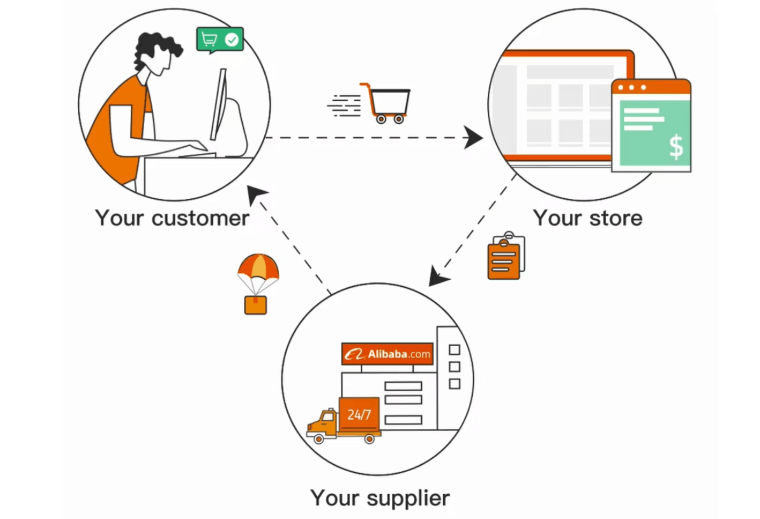
Key Concepts That You Need to Know:
1. MOQ (Minimum Order Quantity)
Most Alibaba suppliers require a minimum order quantity (MOQ), which means you need to buy in bulk. This contrasts with AliExpress, which allows single-item purchases without MOQ but at a higher cost per unit.
2. Customization
Alibaba allows sellers to customize product designs, packaging, and branding, enabling differentiation in a crowded market.
3. Branding
By leveraging customization options, sellers can create private-label products to build a strong, recognizable brand and improve customer loyalty.
Alibaba vs. AliExpress: Key Differences at a Glance
| Feature | Alibaba Dropshipping | AliExpress Dropshipping |
| Supplier Type | Manufacturers and large wholesalers | Small retailers and wholesalers |
| MOQ Requirement | Usually requires MOQ (bulk orders) | No MOQ, single-item purchases allowed |
| Pricing | Lower unit price, better for bulk purchasing | Higher price per unit, better for testing |
| Product Customization | Supports product, packaging, and branding customization | Limited customization options |
| Shipping Speed | Longer production and shipping times | Faster shipping, suitable for quick testing |
| Best For | Sellers ready to invest, scale, and brand | Beginners, small budgets, fast product testing |
🔗AliExpress vs. Alibaba: Which One Is Better for E-commerce
DSers × Alibaba: A New Official Integration for Dropshippers
To help sellers efficiently leverage Alibaba’s resources, DSers recently announced an official partnership with Alibaba. Through DSers, dropshippers can:
- Quickly find and connect with trustworthy suppliers on Alibaba
- Automatically update product details and inventory levels to prevent stock discrepancies
- Place orders with one click and automate order and shipping management
- Access multiple secure payment options
| Get Started Now to Grow Your Online Business with the Best AliExpress Dropshipping Tool - DSers! |
This integration greatly simplifies Alibaba dropshipping operations, allowing sellers to focus on product selection and marketing while building a reliable supply chain.
2. Benefits and Challenges of Using Alibaba for Dropshipping
Key Advantages: Lower Cost, Branding Power, Supplier Relationships
Alibaba stands out as a powerful dropshipping source due to several core benefits:
- Lower Costs: By purchasing directly from manufacturers or large wholesalers, dropshippers can access significantly lower prices compared to retail or small-scale suppliers, improving profit margins.
- Branding Power: Alibaba provides a wide range of customization services, enabling sellers to produce exclusive private-label items with tailored packaging—a key factor for building strong brand recognition and customer loyalty.
- Strong Supplier Relationships: Alibaba encourages direct communication and negotiation with suppliers. Building trustworthy relationships can lead to better pricing, flexible MOQ terms, faster responses, and priority service.
Challenges to Watch For: Communication, Fulfillment Time, MOQ
While Alibaba offers many benefits, dropshippers should be aware of common challenges:
- Communication Barriers: Differences in language, time zones, and cultural expectations can sometimes complicate supplier interactions. Clear and professional communication is essential.
- Longer Fulfillment Times: Compared to platforms like AliExpress, Alibaba orders often involve bulk production and longer shipping times. Planning for lead times and clear delivery expectations is critical.
- Minimum Order Quantities (MOQ): Many Alibaba suppliers require MOQs, which can mean larger upfront investment and inventory risk compared to the no-MOQ model of AliExpress.
Is It Right for You? Decision Factors for Different Seller Types
Alibaba dropshipping is ideal for sellers who:
- Are ready to invest upfront to get better pricing and branding control
- Want to build a unique brand rather than resell generic products
- Have the patience to manage supplier relationships and longer shipping timelines
If you’re a beginner or prefer testing products with minimal risk, starting with AliExpress might be more suitable. But for long-term growth and brand building, Alibaba combined with tools like DSers can be a game-changer.
3. Why Alibaba Makes Sense for Your Store in 2025
In today’s evolving dropshipping landscape, choosing the right sourcing platform is crucial for long-term success. Alibaba offers unique advantages that help sellers move beyond one-time sales towards building a sustainable, scalable brand. This section explains why Alibaba is a smart choice for your store in 2025.
The New Dropshipping Mindset: Build, Not Just Sell
Dropshipping is evolving. In 2025, it’s no longer enough to just sell trending products — the real opportunity lies in building long-term, brand-driven businesses.
Alibaba empowers this transformation. Unlike While AliExpress suits quick product testing, Alibaba offers direct access to manufacturers, competitive pricing, and comprehensive customization, helping you craft truly unique products.
Alibaba’s Role in Scaling a Brand vs. AliExpress’s Role in Testing
The best dropshipping businesses don’t choose between AliExpress and Alibaba — they sequence them:
- Begin with AliExpress to validate market demand while keeping initial risk low.
- Move to Alibaba once you’ve validated the product to reduce cost, customize, and scale profitably.
Want to see how AliExpress and Alibaba can work together?
👉 Jump to Section 5: Unified Testing + Scaling Strategy
How DSers Empowers a Brand-First Strategy
With the new DSers × Alibaba integration, switching to Alibaba is now beginner-friendly. You get:
- A verified supplier network built for dropshipping
- Seamless product and order sync
- Automation for scaling without operational chaos
Alibaba opens doors to brand building, cost savings, and customization, all while DSers integration simplifies the transition. Together, they offer a powerful combo to level up your dropshipping business in 2025.
4. Step-by-Step Process to Start Dropshipping with Alibaba
A successful dropshipping journey on Alibaba requires a clear, professional workflow. This section walks you through each step, with actionable tips and common mistakes to avoid—ideal for beginners and experienced sellers alike.
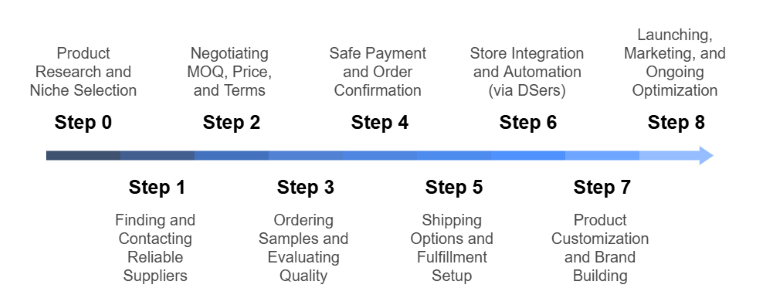
Step 0: Product Research and Niche Selection
Before contacting any supplier, you need to know what to sell. Use tools like Google Trends, TikTok Creative Center, and keyword platforms to identify high-demand, low-competition products within a clear niche.
✅ Suggestions:
- Focus on evergreen niches (e.g., home office, wellness, tech accessories)
- Validate with search trends + competitor research
⚠️ Pitfalls to Avoid:
- Jumping into saturated markets without differentiation
- Choosing low-margin products with high logistics costs
Step 1: Finding and Contacting Reliable Suppliers
On Alibaba, look for suppliers with high response rates, verified badges, and trade assurance. Use filters to narrow down to those that support dropshipping or low MOQ.
✅ Suggestions:
- Use Alibaba's "Verified Supplier" and "Ready to Ship" filters
- Contact 3–5 suppliers to compare professionalism, response time, and willingness to negotiate
⚠️ Pitfalls to Avoid:
- Assuming all suppliers accept dropshipping
- Ignoring supplier reviews or business license info
Step 2: Negotiating MOQ, Price, and Terms
Once in contact, clarify the minimum order quantity (MOQ), unit cost, lead time, and return policy. Good negotiation can unlock lower MOQs or value-added services.
✅ Suggestions:
- Be honest about your dropshipping model
- Ask about sample availability, tiered pricing, and logistics support
⚠️ Pitfalls to Avoid:
- Failing to confirm hidden fees (packaging, branding, shipping)
- Not getting written confirmation of agreed terms
Step 3: Ordering Samples and Evaluating Quality
Never skip this step. A physical sample helps you assess product build, packaging, and supplier communication.
✅ Suggestions:
- Order from multiple suppliers if possible
- Capture unboxing experiences of your products to use as marketing material later on.
⚠️ Pitfalls to Avoid:
- Judging quality only from photos or certificates
- Avoid rushing into large bulk orders without first reviewing sample quality.
Step 4: Safe Payment and Order Confirmation
Use secure and trackable payment methods to protect your purchase.
✅ Suggestions:
- Prioritize Trade Assurance (Alibaba escrow service)
- If not available, consider PayPal (where accepted) or credit cards over direct wire transfers
⚠️ Pitfalls to Avoid:
- Using Western Union or untraceable methods
- Not aligning payment schedule with delivery deadlines
Step 5: Shipping Options and Fulfillment Setup
Decide whether to let the supplier ship directly (if they support dropshipping) or to use a third-party fulfillment center for faster and branded delivery.
✅ Suggestions:
- Compare shipping methods (ePacket, YunExpress, private line, etc.)
- For custom packaging or faster delivery, consider 3PL warehouses
⚠️ Pitfalls to Avoid:
- Not confirming tracking integration
- Underestimating shipping cost and time impact
Step 6: Store Integration and Automation (via DSers)
Now connect your store (Shopify, WooCommerce, etc.) with DSers to automate order sync, tracking, and supplier management.
✅ Suggestions:
- Use DSers to map multiple suppliers and streamline fulfillment
- Enable auto-updates for inventory and price syncing
⚠️ Pitfalls to Avoid:
- Manually tracking orders without automation
- Skipping DSers features like supplier optimizer or variant mapping

|
Adapt Your Product Prices Automatically DSers Automatic Pricing - Pre-set Pricing Rule to mark-up your product price automatically |
Step 7: Product Customization and Brand Building
Once a product is validated, take steps to make it your own. Customization boosts brand value and long-term retention.
- 7a. Post-Validation Branding (For Beginners)
Start branding after you’ve confirmed demand. Request logo printing, branded packaging, and inserts from the supplier.
- 7b. Early Customization (For Experienced Sellers)
If you’ve built stores before, negotiate branding and product tweaks from the beginning to create differentiation.
✅ Suggestions:
- Add QR codes, thank-you notes, or website links in packaging
- Ensure the supplier sends photos of branded samples before production
⚠️ Pitfalls to Avoid:
- Relying on generic product pages
- Forgetting to calculate branding cost into pricing
Step 8: Launching, Marketing, and Ongoing Optimization
With everything ready, it’s time to go live. Promote via paid ads, influencer seeding, or content marketing. Continue testing and optimizing as you grow.
✅ Suggestions:
- Monitor customer reviews and feedback to refine your product listings continuously.
- Use upsells, bundles, and retargeting for AOV and LTV
⚠️ Pitfalls to Avoid:
- Launching without proper product pages or copy
- Not monitoring supplier performance over time
5. Alibaba Meets AliExpress: A Unified Approach to Product Testing and Scaling
To maximize success, many dropshippers leverage both AliExpress and Alibaba strategically. This dual approach lets you test new products quickly while scaling winning items cost-effectively. Here we dive into how to use both platforms in harmony.
Practical Strategy: Use AliExpress to Test, Alibaba to Scale
This dual-platform model is one of the smartest dropshipping strategies in 2025:
- Test small batches with AliExpress
- Scale proven winners with Alibaba
It lets you validate trends, reduce upfront cost, and still grow a brand.
Reduce Risk with Cross-Supplier Inventory Management
Running both platforms in parallel means:
- Backup options when one supplier runs out
- Split sourcing for different regions or shipping methods
- Data-based decision making with A/B performance
Syncing Platforms with DSers
Tools like DSers make multi-platform operations possible, without the chaos:
- Assign suppliers to different SKUs or countries
- Automate order routing and inventory sync
- Monitor multiple fulfillment pipelines from one dashboard
Using both AliExpress and Alibaba allows for more flexible sourcing strategies, reduces potential risks, and supports more efficient business scaling. With automation tools like DSers, managing this hybrid strategy becomes efficient and manageable.
Want to know exactly how to combine AliExpress and Alibaba? See the full step-by-step workflow below. 👇
📘 Step-by-Step: How to Combine AliExpress and Alibaba in Your Dropshipping Workflow
Step 1 – Test with AliExpress: Use DSers to import products from AliExpress to your store. Launch ads or organic traffic to validate interest. Focus on small-batch testing without customization.
Step 2 – Track Results: After 7–14 days, use analytics (conversion rate, return rate, order count) to identify high-performing products worth scaling.
Step 3 – Source via Alibaba: Search for the same product on Alibaba. Contact suppliers who accept small MOQ and ask about customization options (logo, packaging, colors).
Step 4 – Switch Fulfillment in DSers: Link your new Alibaba supplier to the same product listing in DSers. Fulfillment will be routed to Alibaba while your store front stays unchanged.
Step 5 – Customize and Scale: Once consistent sales are confirmed, request custom branding or packaging. You can scale using Alibaba’s better pricing and logistics, while continuing to test new products via AliExpress.
6. Trending Alibaba Product Categories for 2025
For 2025, categories like smart home tools, wellness accessories, office upgrades, and eco-friendly products remain in high demand. These niches offer excellent growth opportunities and supplier availability on Alibaba.
💡 Want more ideas? We’ve published several in-depth articles covering product trends, selection strategies, and category breakdowns.
Each guide includes real examples, keyword insights, and supplier suggestions to help you find the right products for your store.
7. Frequently Asked Questions (FAQ)
• Import products from AliExpress and Alibaba
• Manage suppliers and fulfillment settings in one dashboard
• Automate order syncing, tracking, and inventory updates
This makes it easy to start with AliExpress and scale with Alibaba as your business grows.
Conclusion
In 2025, dropshipping is no longer about chasing quick wins—it’s about building long-term value. With Alibaba, you gain access to powerful tools for customization, cost control, and supplier relationships that help you scale sustainably. And with DSers now officially integrated with Alibaba, transitioning from product testing to full-scale fulfillment has never been easier.
Start small. Test smart. Then use Alibaba to build a brand that lasts. Your future store deserves more than just fast trends—it deserves a foundation.





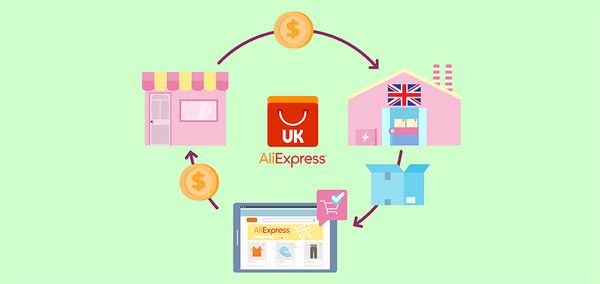
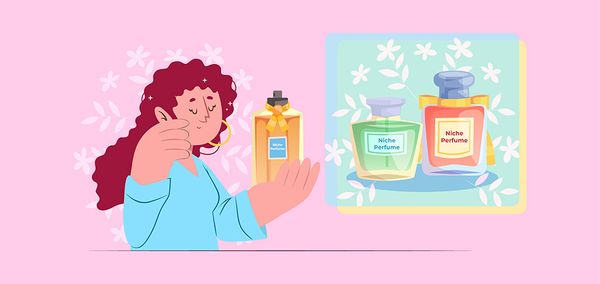





 Company
Company
 Why Choose DSers
Why Choose DSers
 Blog
Blog
 Help Center
Help Center




 Live Chat
Live Chat